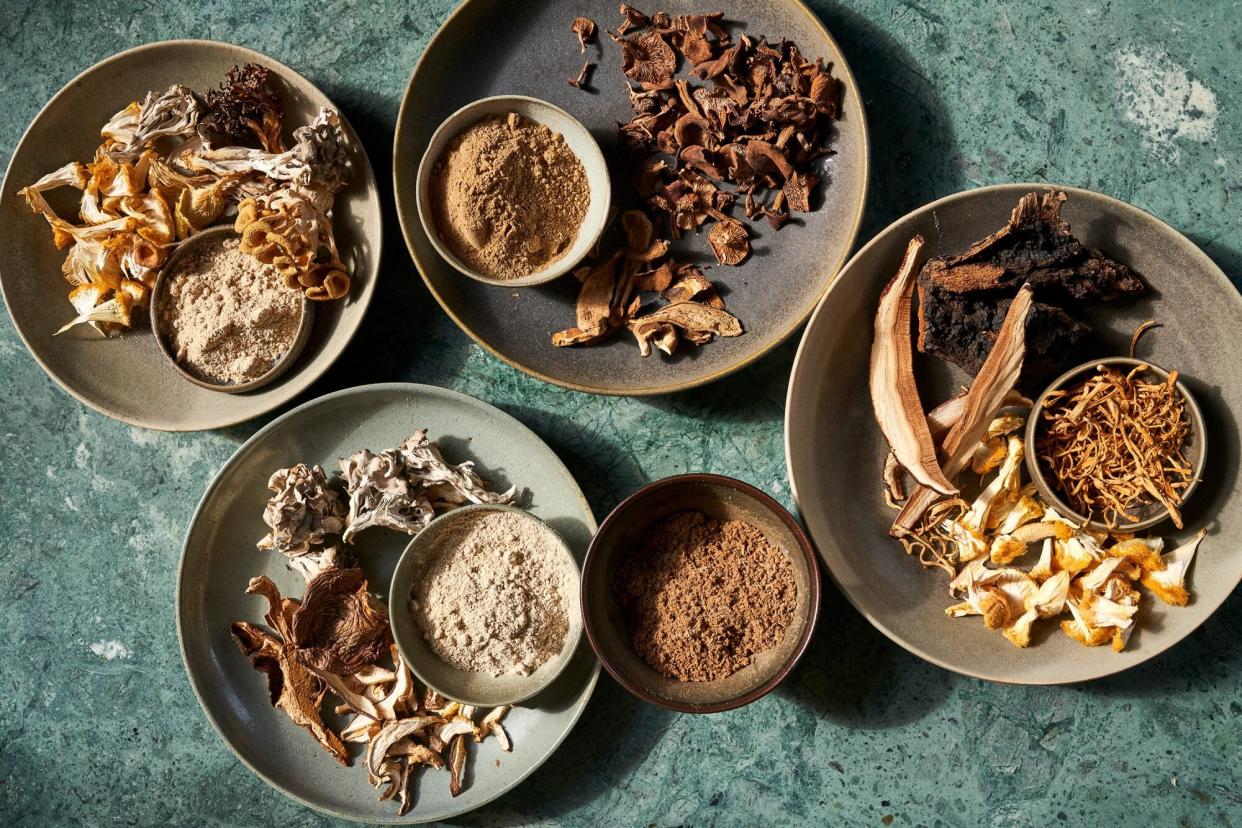Mushroom Powder Is the Ultimate Way to Add Umami to All Kinds of Dishes—Here's How to Use It in Your Cooking

TABLE OF CONTENTS
On This Page
Flavor Profile
Why Homemade Is Best
How to Make Mushroom Powder
How to Cook With Mushroom Powder
What if someone told you there's an incredibly easy way to add umami to your home cooked meals, from a fluffy egg scramble at breakfast to a late night chocolate indulgence? You might be surprised to learn that the secret lies in an ingredient that's as accessible as any number of spices you already have in your pantry, with flavors that are just as varied and wide-ranging—from soft and subtle to pungent and pronounced. That ingredient is mushroom powder.
Andrea Gentl, author of Cooking with Mushroom: A Fungi Lover's Guide to the World's Most Versatile, Flavorful, Health-Boosting Ingredients, is on a mission to share that secret with home cooks everywhere. She's a fervent fungiphile, and a proponent, a zealot even, of the power of mushroom powders to improve your everyday cooking. She uses them constantly, in all manner of savory dishes, and a surprising number of sweets.
Related: Our Mushroom Glossary Will Help You Get to Know More Varieties
Mushroom Powder Is an Umami Bomb
Gentl devotes a section of her book to drying fresh mushrooms and pulverizing them into powders. Dehydrating brings out a "deep umami flavor," she says. And though you can find several varieties of cultivated mushrooms year-round in grocery stores and online, there are many more interesting varieties that appear only seasonally, and briefly at that. "Drying the varieties with short seasonal windows is a great way to preserve these flavor bombs," Gentl says. "And the new dishes you can dream up are endless once you have an array of them on hand."
Among the easiest ways to start experimenting with the flavor profiles of mushrooms is to dry them into powders. Gentl likes the ease of adding powdered mushrooms to dishes because they boost flavors in a concentrated way, even more so than fresh varieties do in many recipes. "I am layering in another flavor profile without adding another textural component," she says.
Why Homemade Mushroom Powder Is Best
You can, of course, buy dried mushroom powders and blends at specialty grocers, health food stores, and directly from some farmers and foragers at greenmarkets, but making your own couldn't be easier. It's also a nice way to use up dried mushrooms you may already have in your pantry. Perhaps there's half a package of dried porcini at the back of a cabinet left over from a pasta recipe, or a few stray shiitakes that didn't make it into a miso soup. Gentl recommends storing dried mushrooms in glass jars, then pulverizing them once you have amassed a few handfuls' worth.
Related: Our Favorite Mushroom Recipes
You can make single-variety powders, though Gentl recommends creating a few custom blends. She combines oyster mushrooms, maitakes, and lion's mane in an all-purpose everyday powder, and tailors others to more specific uses, like a super health-boosting adaptogenic powder (with reishi, codyceps, and lion's mane) and a mix of maple-forward candy caps and earthy porcini that works especially well in chocolate desserts.
How to Make Mushroom Powder
Use a spice grinder, food processor, or blender (or a mortar and pestle if you're the patient, meditative type) to make your own mushroom powder:
Place the dried mushrooms in the spice grinder and pulse or grind them to a powder.
Sift the powder through a mesh sieve, remove any large pieces, and buzz or grind again till the powder is uniformly fine.
Transfer the powder to a glass jar with a tight-fitting lid, seal and label, and store in your refrigerator or freezer.
The powder should last indefinitely, but Gentl recommends putting it to use immediately.
How to Use Mushroom Powder in Your Cooking
The list of possibilities for cooking with mushroom powders is indeed endless, but here are a few ideas to get you started:
Add a few pinches to the mix the next time you make granola, or toss with vegetables just before roasting.
Use the powders to flavor broths, soups, stews, and curries.
Make a dry rub for meat, poultry, or fish.
Mix a compound butter with mushroom powder, coarse salt, and chopped herbs.
Whisk a teaspoon or so into the dry ingredients for brownies or spice cookies.
One of Gentl's favorite ways to put the powder to use is by making mushroom salt, which adds umami at the finish of nearly any savory dish. Fittingly, she uses it to salt the rims of cocktail glasses she uses for her signature mushroom cocktails, including a margarita, a Negroni, and a French 75. It's yet another way to celebrate the world of flavor to be found in a few handfuls of mushrooms.

